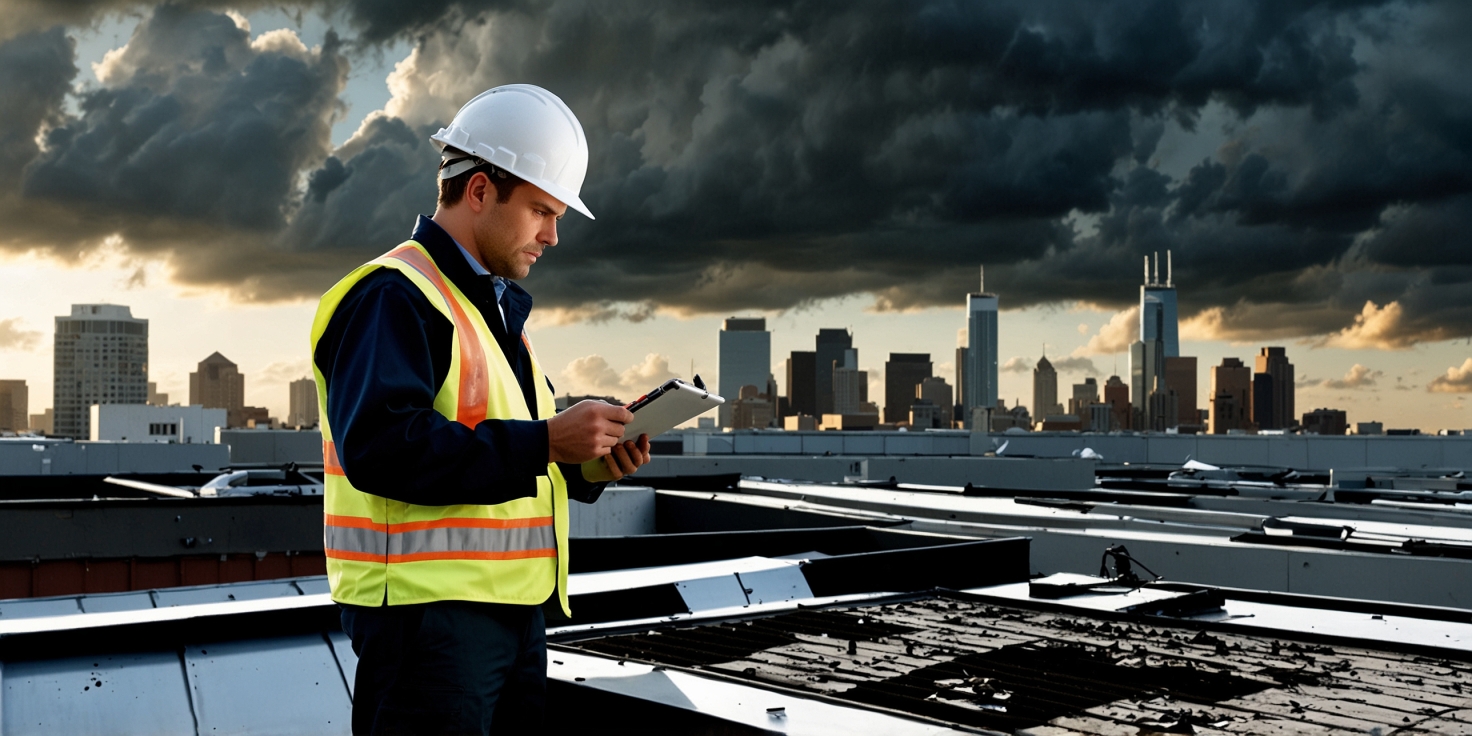When strong winds strike, rooftop units such as HVAC systems, exhaust fans, and other mechanical equipment are often among the first to suffer damage. Filing a claim for wind damage to rooftop units can be a complex and frustrating process, especially when dealing with insurance companies that may undervalue or deny your claim. At LMR Public Adjusters, we understand the challenges that property owners in South Florida face when their buildings are impacted by severe weather. As a trusted provider of full-spectrum public adjusting services, we specialize in helping homeowners and businesses in cities like Miami, Fort Lauderdale, West Palm Beach, Naples, Orlando, and Tampa navigate the insurance claims process with confidence.
Our experienced team of insurance claim adjusters in Hollywood is well-versed in handling wind damage claims, including those involving rooftop units, structural damage, and other storm-related issues. We conduct thorough inspections, document all damages, and negotiate directly with your insurance company to ensure you receive the maximum compensation you deserve. Whether you’re dealing with storm damage, water intrusion, or mechanical failure due to high winds, LMR Public Adjusters is here to advocate for your best interests. With our “No Recovery, No Fee” policy and free claim assessments, you can trust us to deliver expert guidance and exceptional service every step of the way.
Assessing Wind Damage to Rooftop Units
When filing a claim for wind damage to rooftop units, the first and most crucial step is accurately assessing the extent of the damage. Rooftop units (RTUs), such as HVAC systems, ventilation equipment, and other mechanical installations, are particularly vulnerable to high winds due to their exposed positions. Proper assessment not only ensures that all damages are documented but also strengthens your insurance claim, increasing the likelihood of a fair settlement.
Wind damage can manifest in various forms, from visible destruction like dislodged units and broken components to more subtle issues such as internal mechanical failures or compromised structural integrity. According to the National Weather Service, wind speeds as low as 45 mph can cause minor damage to rooftop equipment, while gusts exceeding 75 mph can lead to significant destruction. This makes it essential to conduct a thorough inspection immediately after a wind event.
Begin the assessment by visually inspecting the rooftop. Look for signs such as shifted or detached units, bent or broken mounting brackets, and torn or missing flashing. These are clear indicators that the wind has impacted the equipment. However, not all damage is visible. Internal components like motors, compressors, and electrical wiring may also suffer from the shock or vibration caused by strong winds. In such cases, professional evaluation is necessary to uncover hidden issues.
“Even minor wind events can cause misalignment or vibration damage to rooftop units, which may not be immediately noticeable but can lead to long-term operational failures,”
notes the American Society of Heating, Refrigerating and Air-Conditioning Engineers (ASHRAE).
It is also important to document all findings meticulously. Take high-resolution photographs from multiple angles, record videos if possible, and maintain a written log of all observed damage. This documentation will serve as critical evidence when submitting your insurance claim. Additionally, gather maintenance records and installation documentation to demonstrate the pre-damage condition of the units.
In many cases, property owners may overlook the importance of professional assessments. Hiring a licensed contractor or a certified public adjuster can make a significant difference. These experts are trained to identify both obvious and hidden damages, ensuring that nothing is missed. They can also provide a detailed report that supports your claim and helps avoid disputes with your insurance provider.
For commercial properties, the stakes are even higher. A malfunctioning HVAC system can disrupt business operations, leading to financial losses. Therefore, business owners should prioritize a prompt and comprehensive damage assessment. If you own or manage a commercial building, consider consulting with specialists in commercial properties to ensure a thorough evaluation.
Another critical aspect is understanding the terms of your insurance policy. Some policies may have specific clauses related to wind damage or rooftop equipment. Reviewing your policy or consulting with a public adjuster can clarify what is covered and what documentation is required. For more information, you can visit the FAQ section on our website.
Here are some examples of what to look for during a wind damage assessment:
- Dislodged or tilted rooftop units indicating structural compromise
- Cracked or broken housing and panels on HVAC systems
- Loose or missing fasteners, brackets, or flashing
- Water intrusion signs around rooftop units due to damaged seals
- Unusual noises or performance issues post-storm, suggesting internal damage
According to FEMA, wind-related damages account for a significant portion of insurance claims following major storms. In hurricane-prone areas, rooftop units are among the most frequently damaged components. This highlights the importance of timely and accurate assessments.
For those located in high-risk zones like Florida, partnering with local experts can be especially beneficial. If you are in the area, consider reaching out to professionals such as the Fort Lauderdale Public Adjusters or the Hollywood Public Adjusters for localized support and expertise.
In conclusion, assessing wind damage to rooftop units is a critical step in the claims process. It requires a combination of visual inspection, professional evaluation, and detailed documentation. By taking a proactive approach and leveraging expert assistance, property owners can ensure that their claims are comprehensive and well-supported, ultimately leading to a more favorable outcome. For more guidance on how to proceed with your claim, visit our detailed section on wind damage.
Steps to File an Insurance Claim Successfully
Filing an insurance claim for wind damage to rooftop units can be a complex process, but following the right steps can significantly improve your chances of a successful outcome. The first step is to assess the damage as soon as it is safe to do so. After a windstorm, inspect your rooftop units for visible signs of damage such as dents, dislodged components, or complete detachment. Document everything thoroughly with clear photographs and detailed notes. This documentation will serve as critical evidence when submitting your claim. Next, review your insurance policy to understand what types of wind damage are covered and what exclusions may apply. Pay close attention to deductibles, coverage limits, and any specific clauses related to rooftop equipment. If you are unsure about the terms, consider consulting a professional who can help interpret the policy language.
Once you have a clear understanding of your coverage, notify your insurance company promptly. Most insurers have a specific time frame within which you must report damage, so acting quickly is essential. When contacting your insurer, provide all necessary details including the date of the storm, the nature of the damage, and any immediate repairs you had to make to prevent further loss. It is advisable to keep a record of all communications with your insurance company, including emails, phone calls, and letters. The next step involves scheduling an inspection with the insurance adjuster. During this visit, the adjuster will evaluate the extent of the damage and determine the payout amount. Be present during the inspection to ensure that all affected areas are thoroughly examined. Share your documentation and point out any damage that may not be immediately visible.
If you feel that the insurance company’s assessment is unfair or incomplete, you have the right to seek a second opinion. Hiring a public adjuster can be beneficial in such cases. Public adjusters work on your behalf to ensure that you receive a fair settlement. They are experienced in handling claims related to wind damage and can help you navigate the complexities of the claims process. For more information about how public adjusters can assist you, visit our about us page. Once the claim is approved, review the settlement offer carefully. Make sure it covers all necessary repairs and replacements. If you agree with the offer, you can proceed with hiring licensed contractors to begin the repair work. Keep all receipts and invoices related to the repairs, as these may be required for reimbursement or future claims.
Throughout the process, maintain open communication with your insurer and follow up regularly to check the status of your claim. Delays can occur, but staying proactive can help expedite the resolution. If you encounter any issues or have questions about the process, our FAQ section provides answers to common concerns related to property insurance claims. Successfully filing a claim for wind damage to rooftop units requires attention to detail, timely action, and a thorough understanding of your insurance policy. By following these steps and seeking professional guidance when needed, you can ensure that your claim is handled efficiently and that you receive the compensation you deserve.
In conclusion, filing a claim for wind damage to rooftop units requires careful documentation, prompt action, and a clear understanding of your insurance policy. By thoroughly assessing the damage, gathering photographic evidence, and working closely with your insurance provider, you can help ensure a smoother claims process and a quicker resolution. Don’t hesitate to consult with a professional if needed, as their expertise can be invaluable in navigating complex claims. Protecting your property starts with being prepared—so take the necessary steps today to safeguard your rooftop units against future wind damage.




